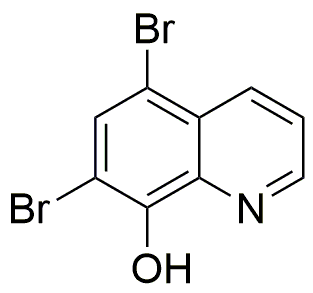5,7-Dibromo-8-hydroxyquinoline is widely utilized in research focused on:
- Antimicrobial Agents: This compound exhibits significant antibacterial and antifungal properties, making it valuable in the development of new antimicrobial agents for pharmaceuticals.
- Analytical Chemistry: It serves as a reagent in analytical methods, particularly in the detection and quantification of metal ions, enhancing the accuracy of environmental and industrial testing.
- Biological Research: The compound is used in studies related to cell signaling and apoptosis, providing insights into cancer research and potential therapeutic pathways.
- Material Science: Its unique properties allow for applications in the development of novel materials, such as sensors and coatings, that require specific chemical interactions.
- Fluorescent Probes: 5,7-Dibromo-8-hydroxyquinoline can be utilized as a fluorescent probe in biological imaging, enabling researchers to visualize cellular processes with high specificity.
General Information
Properties
Safety and Regulations
Applications
5,7-Dibromo-8-hydroxyquinoline is widely utilized in research focused on:
- Antimicrobial Agents: This compound exhibits significant antibacterial and antifungal properties, making it valuable in the development of new antimicrobial agents for pharmaceuticals.
- Analytical Chemistry: It serves as a reagent in analytical methods, particularly in the detection and quantification of metal ions, enhancing the accuracy of environmental and industrial testing.
- Biological Research: The compound is used in studies related to cell signaling and apoptosis, providing insights into cancer research and potential therapeutic pathways.
- Material Science: Its unique properties allow for applications in the development of novel materials, such as sensors and coatings, that require specific chemical interactions.
- Fluorescent Probes: 5,7-Dibromo-8-hydroxyquinoline can be utilized as a fluorescent probe in biological imaging, enabling researchers to visualize cellular processes with high specificity.
Documents
Safety Data Sheets (SDS)
The SDS provides comprehensive safety information on handling, storage, and disposal of the product.
Product Specification (PS)
The PS provides a comprehensive breakdown of the product’s properties, including chemical composition, physical state, purity, and storage requirements. It also details acceptable quality ranges and the product's intended applications.
Certificates of Analysis (COA)
Search for Certificates of Analysis (COA) by entering the products Lot Number. Lot and Batch Numbers can be found on a product’s label following the words ‘Lot’ or ‘Batch’.
*Catalog Number
*Lot Number
Certificates Of Origin (COO)
This COO confirms the country where the product was manufactured, and also details the materials and components used in it and whether it is derived from natural, synthetic, or other specific sources. This certificate may be required for customs, trade, and regulatory compliance.
*Catalog Number
*Lot Number
Safety Data Sheets (SDS)
The SDS provides comprehensive safety information on handling, storage, and disposal of the product.
DownloadProduct Specification (PS)
The PS provides a comprehensive breakdown of the product’s properties, including chemical composition, physical state, purity, and storage requirements. It also details acceptable quality ranges and the product's intended applications.
DownloadCertificates of Analysis (COA)
Search for Certificates of Analysis (COA) by entering the products Lot Number. Lot and Batch Numbers can be found on a product’s label following the words ‘Lot’ or ‘Batch’.
*Catalog Number
*Lot Number
Certificates Of Origin (COO)
This COO confirms the country where the product was manufactured, and also details the materials and components used in it and whether it is derived from natural, synthetic, or other specific sources. This certificate may be required for customs, trade, and regulatory compliance.


